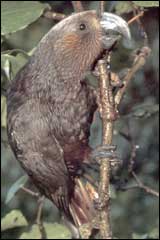|
|
|||
|
||||
|
Updated: September 12, 2001 |
|
|
|||||||||||||||||||||||||||||||||||||||||||||||||||||||||||||||||||||||||||||||||||||||||||||||||||
 Kaka fly from Little Barrier Island to feed on Tiritiri Matangi |
|
 Kaka chewing on a coprosma stem |
Kaka (Nestor meridionalis) are found in both the North and South Islands of New Zealand. They are part of the parrot family of birds and are close relations of the kea.
North Island kaka are of a duller brown colour than their South Island cousins. The feathers are grey to dark brown without the silvery head feathers. They are also smaller. They have very powerful wings and can fly long distances.
Many of the kaka populations on the mainland have become extinct. Great Barrier Island provides one of the last refuges for the bird in the greater North Island area, especially as there are no mustelid present.
Kaka feed on a variety of foods in the podocarp/kauri forests. Seasonally flowering plants such as pohutukawa, puriri and rewarewa produce large amount of nectar which the kaka collect with their bristle tipped tongue. Kaka also have a very strong curved bill which they use to rip bark from trees to lick the sap or hunt for huhu grubs. Honeydew is a low priority in the northern forests as there are many other trees which produce large quantities of nectar. The seeds of kauri are also a favourite. They eat surface dwelling invertebrates such as bag moths, scales and weta eggs. Kaka use their claws to pick up food and hold it while they eat.
Their breeding cycle is not determined by beech masting cycles and so are known to breed each year. They nest in hollow trunks often in pohutukawa, puriri and matai trees.
|
|
|
|
|
|
|
|
Olive-brown/dark brown Red underside of wings |
Warmth Courtship |
|
|
Versatile |
Displaying, courtship |
|
|
|
Extremely strong Black
(Brush tongue) |
Ripping cones Breaking decaying wood Extracting larvae and beetles Walking, balance Preening (Nectar feeding) |
|
|
|
|
Perching Walking, hopping |
|
|
|
4 white eggs 24 days to hatch |
|